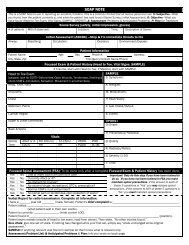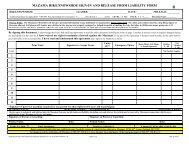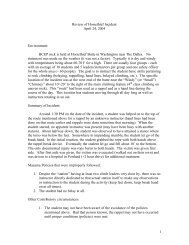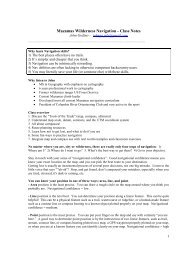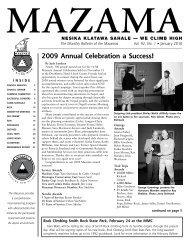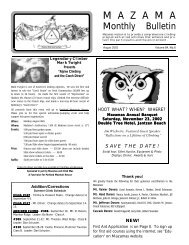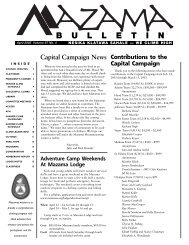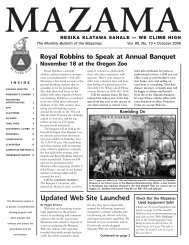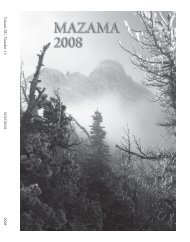1 Mazamas Risk Management Review Written by: Josh Lockerby ...
1 Mazamas Risk Management Review Written by: Josh Lockerby ...
1 Mazamas Risk Management Review Written by: Josh Lockerby ...
You also want an ePaper? Increase the reach of your titles
YUMPU automatically turns print PDFs into web optimized ePapers that Google loves.
<strong>Mazamas</strong> <strong>Risk</strong> <strong>Management</strong> <strong>Review</strong><strong>Written</strong> <strong>by</strong>: <strong>Josh</strong> Locker<strong>by</strong>, Steve Heim, Sylvia Cate, Tim Hale, Kellie RiceContributions to this report made <strong>by</strong>: Diane Kong, Mike Johnson, Terry Barclay, RobertMatteri, Joyce Nielsen, Mary Wolin-Green, Wayne Martin, Susan Gygan, Pete PetersonThis review was based on written reports (with verbal follow-up) submitted <strong>by</strong> thosedirectly involved with the incident described below.Climb: Mt Stuart (Ulrich Couloir) Grade: B+ Date of incident: 9-1-02Climb teams involved:<strong>Mazamas</strong> climb # 220 (8 persons)A private group that tagged along with climb #220 (2 persons)<strong>Mazamas</strong> climb # 221 (4 persons)Washington Alpine Club team (2 persons)Authorities: Chelan County SheriffClimb team qualifications:Leader and assistant: They knew the route. They both have had <strong>Mazamas</strong> educationthrough Leading Fifth Class Rock. They have been Mazama climb leaders for a fewyears.Rest of the group: Mixed range of experience form BCEP to Advanced. Some hadmountaineering first aid training.The following is a description of the incident itself and is based on reports filed <strong>by</strong> thoseinvolved in the incident itself. Thanks are given to those who contributed to this report.The climb team (climb # 220) was just beginning their decent of the summit ofMt. Stuart down the Cascadian col. At about 11:30 AM between the summit and the falsesummit, someone missed a foot hold while traversing on fourth class rock (unroped). Aforty to sixty foot fall resulted. While nobody saw the beginning of the fall, most saw theend of it. The victim was instructed not to move as three of the team members movedover to provide first aide. One of the three was an M.D. and became the primary firstaider and assessed a broken arm, possible broken rib in the back, and facial injury aroundthe eye. After a thorough assessment was made on the back and legs (no apparentinjuries), the injured was able to walk and rejoin the group where the arm was splinted.Meanwhile, 911 was called and they were connected to the Chelan County Sheriff (therewas constant communications made <strong>by</strong> cell phone during the course of the impendingevacuation). The weather consisted of some wind and low visibility so a directevacuation from the accident site was not viable. The team was notified of a landing site1
at 7400 feet (the accident was at 9100 feet) and could lift from there if the weatherallowed. The team began a slow process of finishing the traverses over the false summitand down a snowfield below. The victim was able to move some on their own, but therewas some aid (rope, Z-systems) used in some areas where it was more difficult. Whilebeing lowered down the snowfield, another Mazama team that climbed the West Ridgeroute met up and assisted with the evacuation. The first thing they did was add on to thelength of rope being used with the second rope from the new team. This had made for alonger rope lower, but was easier on the whole evacuation. The victim was now at 8500feet. There was a third team from the Washington Alpine Club that had been around andhad gone down the their camp at 7400 feet and returned to the 8500 foot level as thevictim arrived. They had brought back a sleeping pad, sleeping bag, and some hotchocolate. The victim was fatigued at that point so a rope litter was assembled and usedfor the rest of the descent.Meanwhile, there were additional communications with the authorities andupdates were being traded back and forth. There was a ground crew approaching fromthe trailhead, but they were several hours away. The weather did improve (more sun andless wind) so a helicopter lift became more viable. As the teams reached 7400 feet, thedecision was made to bring in the helicopter. The victim was picked up and flown out ataround 6:45 PM the same day. The West Ridge group and the Washington Alpine Clubbivied there and the rest went down to Ingalls Creek to sleep.Afterward:-The victim was treated at the hospital in Wenatchee that night. Since then, additionalcomplications have arisen, and additional treatment is continuing at the time of thisreport.-Everyone else made it home safely-There was a debriefing held <strong>by</strong> the Mazama Debriefers in the days after the incident.Mazama policy prohibits disclosure of any details of such meetings because it is meant tobenefit those who were involved.-<strong>Risk</strong> <strong>Management</strong> Committee recommended a re-wording of the <strong>Mazamas</strong> rescueinsurance policy and forwarded it to Executive Council.Observations:-This was listed as a “B” climb. It may be a “C” route however it should be noted thatthe group, based on written reports and verbal interview, was “C” grade capable.-The place where the fall occurred is traditionally done un-roped although it is exposed.Some follow-up dialogue confirmed that safety was a priority in the group and peoplewere reminded, at the start of the climb, that protection was available on request, if it wasnot being used. It does not appear that anyone had concern over the traverse. One person2
noted that the victim may have been slightly off route and the weather may havecontributed some as well.-There were cell phones used, but they were not full charged. There was no failure ofpower in this climb, however.-The “Standard” rope litter design used has some deficiencies that make it cumbersome attimes.-The Mazama pager system was used, but not until about 7:00 PM. Part of the reasoningfor the delay was a desire to conserve power in the cell phone.-The only policy that may have been “bent” might have been having the other group of 2tag along during the course of the climb. However, reports show that this was a judgmentcall on the side of safety and no wilderness rules were broken. Nor did their presencecontribute to the cause of the incident.-A member of the helicopter crew gave their compliments to everyone and was heard tosay “You guys have done an amazing job.”-All safety policies were followed which included the proper use of ropes where needed,use a equipment (seat harness, helmet).Conclusion:-The only possible prevention may have been to remind everyone of safety and that handlines are available on request, particularly where there is exposure. It is not therecommendation of <strong>Risk</strong> <strong>Management</strong> that a hand line should be used in this location –unless conditions dictate or it is requested. In this climb, hand lines were used at otherlocations.-Overall, all involved were properly equipped and Mazama policy and training wascarried out properly and it worked.-Although the victim and the primary first aider feel that the evacuation made <strong>by</strong> theMazama group did not cause any significant injury, the group was in a situation wherethe risk of additional injury to the victim was high. The decision to evacuate wasdetermined because of exposure - which was a good call, but under better weatherconditions, one might have stayed and waited for additional help.-This incident is an excellent example of an incident that forced the climb team to adjustto new obstacles, and overcome them in a safe and timely manner considering theconditions. It also exemplifies the need for proper equipment and training when such asituation occurs.3
Climbing Committee’s Responses to the Mt. Stuart Recommendations-Climbing Committee to consider the re-grading the climbing route to “C”The Climbing Committee agrees and the route has been changed to a “C”-Consider a better rope litter design.Over the last few years the Climbing Committee has been teaching, through it’s schoolsand leader training a new and simpler type of litter system sometimes referred to as the“Locker<strong>by</strong> Litter”. The committee believes that teaching this type of litter as well as thestandard type is sufficient for our training.-Keep on emphasizing safety on a climb.The Climbing Committee through its schools and leadership development programcontinues to remind leaders and students to always emphasize safety on climbs.-Reinforce the idea: If carrying a communications device, have sufficient power andbackup power.The Climbing Committee feels that leaders who do have communication devices on theirclimbs already understand the importance of keeping them charged.-<strong>Mazamas</strong> should review evacuation training – make sure any training includes adiscussion on when not to evacuate.The Climbing Committee believes that this recommendation should be passed onto theFirst Aid Committee. How to package a patient, when to evacuate or not to evacuate areissues which should be discussed and possibly included in Wilderness First Aid.4



